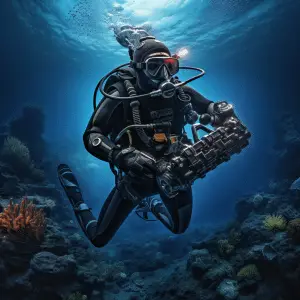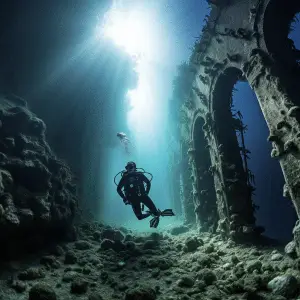Scuba diving is more than just a sport—it’s a doorway into a mesmerizing world bustling with vibrant coral gardens, exotic marine creatures, and untouched undersea landscapes. This adrenaline-pumping adventure, however, requires an appropriate balance of diving knowledge, preparation, and respect for the marine ecosystem.
With these comprehensive scuba diving tips and tricks, you’ll be equipped to enhance your underwater experience while ensuring your safety and the preservation of the marine environment.

The Cornerstone of Scuba Diving: Pre-Dive Preparations
Every memorable and successful dive is built upon a foundation of meticulous pre-dive preparation. Preparing for a dive involves getting comfortable with your gear, ensuring its functionality, having a competent diving instructor, and creating a comprehensive dive plan. This section will detail these crucial steps in the pre-dive preparation process, guiding you toward a safe and rewarding scuba diving trip.
Investing in the Right Gear
While renting scuba equipment may seem a practical choice initially, nothing beats the comfort and familiarity of personal gear when you are dozens of feet underwater. Investing in your own set of gear ensures a perfect fit, boosting your confidence and overall diving experience.
Ensure that your mask fits snugly without being overly tight. A well-fitting mask helps avoid leaks and provides a clear field of vision underwater. Scuba diving tips and tricks, Your wetsuit should be of the right thickness to match the water temperature and fit snugly, allowing for flexible movements while retaining body heat. Fins need to fit comfortably and snugly over your feet or boots without causing chafing. A high-quality, well-maintained regulator is critical for seamless breathing.
Gaining Comfort with Your Equipment
Before you hit the water with your dive buddy, spend time familiarizing yourself with your gear. Practice assembling and disassembling your equipment multiple times. This familiarity can prove lifesaving during potential equipment issues underwater.
It’s also essential to perform a pre-dive safety check. This routine check—of your BCD/Buoyancy, weights, releases, air, and final okay (often remembered with the acronym BWRAF)—can help identify and correct issues before they become hazardous underwater.
Dive Planning: An Essential Safety Measure
Every successful dive begins with a comprehensive dive plan. This plan should address critical factors such as maximum depth, total bottom time, air supply management, safety stops, and emergency procedures. Additionally, acquaint yourself with the specifics of dive sites, including potential hazards, currents, visibility, and marine life. A good dive plan not only enhances your diving experience but also significantly reduces risks.
Elegance Underwater: Mastering Navigation and Movement
Moving underwater is an art form—one that balances the fine line between maintaining personal safety and respecting the delicate marine life around you. Mastering your diving skills underwater is an essential component of scuba diving, and it involves much more than merely partnering up with a dive instructor with a diving certification. Here’s how to achieve perfect buoyancy to scuba dive safely:
Achieving the Perfect Buoyancy Balance
Mastering buoyancy control is arguably the most critical aspect of scuba diving. Scuba diving tips and tricks, Good buoyancy control allows you to glide effortlessly over reefs, hover in the water column, and safely ascend and descend.
Achieving neutral buoyancy—where you are neither sinking nor floating—requires practice and understanding of your BCD and how your lungs act as natural buoyancy compensators. Regular buoyancy checks and slight adjustments during your dive can significantly affect your air consumption and protect marine life from inadvertent damage.
Finning Techniques: The Key to Efficient Movement
Understanding and using different finning techniques greatly improve your underwater mobility and control. The flutter kick is good for open water and strong currents, while the frog kick is ideal for delicate environments like coral reefs or shipwrecks, minimizing silting and damage. A modified bent-knee or bicycle kick can help you maintain position while observing marine life or adjusting equipment.
Dive Compass: Your Navigation Companion
Navigating underwater can be a tricky business, especially in areas with poor visibility or intricate landscapes. Learning to use a dive compass effectively can mean the difference between an easy return to the dive boat or a long, uncertain swim. A compass will help you keep your bearings and find your way back to your starting point, even in the most challenging conditions.
The Underwater Code: Respecting the Marine Ecosystem
In the captivating realm of scuba diving, we are visitors. The ocean and its myriad inhabitants have a delicate balance that can be easily disrupted by irresponsible actions. By following proper dive briefing, beginner divers can respect and protect the dive site. This section explores the ‘Underwater Code,’ a set of guidelines that every diver should follow to preserve and respect the marine environment.
Observing Marine Life: A Non-Contact Sport
A golden rule in scuba diving is to look but not touch. Disturbing marine life can stress or harm them, and certain species can be dangerous when threatened. Remember, you are a visitor in their world—admire, but always maintain a respectful distance.
Mastering Buoyancy: Minimizing Environmental Impact
Good buoyancy control plays a vital role in preserving the marine ecosystem. It ensures that you don’t accidentally touch, bump into, or break delicate coral formations or stir up the bottom sediment, which can harm marine life.
Post-Dive Procedures: Ensuring Self and Gear Care
The success of a dive isn’t measured just by the exhilaration during the dive, but also by how effectively you wind down afterward. The post-dive period is a crucial time for both your physical wellbeing and the care of your equipment. Here’re some post-dive procedures that ensure the health of both the diver and the scuba gear:
Post-Dive Body Care
After you dive deeper, it’s important to hydrate to help your body recover and aid in the removal of residual nitrogen. Eating a balanced meal replenishes lost energy, and a good rest allows your body to recover fully. Listen to your body—if you feel unduly tired, dizzy, or unwell, seek medical attention immediately.
Gear Maintenance: Rinse, Dry, and Store
Proper gear maintenance significantly extends the life of your scuba equipment. Rinse your gear thoroughly with fresh water after each dive to remove salt, sand, and other residues. Dry your equipment out of direct sunlight, as UV rays can damage certain materials. Store your gear properly to prevent damage and ensure it’s ready for your next dive.

Conclusion
Scuba diving is an exhilarating journey into the mysterious underwater world, but it requires careful preparation, ongoing learning, and a deep respect for marine life and environments. These tips and tricks will help ensure that every dive is not only an incredible adventure but also a safe and environmentally responsible one. So gear up, dive in, and explore the extraordinary beneath the waves!
